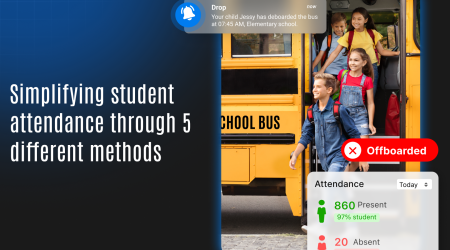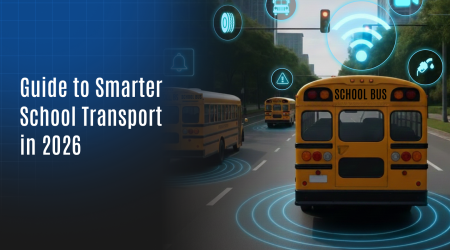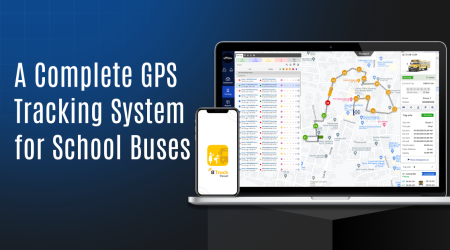Custom Alerts Revolutionizing Emergency Response Times in School Commute

In today’s fast-paced world, ensuring the safety of school children during their daily commutes is paramount. The School System company has taken a significant leap forward by integrating custom alerts into their school bus monitoring software, drastically improving emergency response times. This blog delves into the intricate journey of the company, highlighting how this innovative approach has transformed their safety protocols and operational efficiency altogether.
Understanding the Challenges Faced by the company
Before diving into the transformative journey of the company, it’s essential to understand the challenges they faced:
Delayed Emergency Responses:
The primary issue was the delay in emergency responses. Without real-time alerts, identifying and addressing emergencies in a timely manner was a significant challenge. Often, incidents such as accidents or medical emergencies went unnoticed for crucial minutes, exacerbating the situation and causing undue distress to students and parents.
Communication Gaps:
There were substantial communication gaps between bus drivers, school administrators, and emergency services. This often led to confusion and delayed actions. For instance, if a bus broke down or a student had a health emergency, the lack of immediate communication channels meant that administrators were sometimes the last to know, delaying critical response measures.
Safety Concerns:
Ensuring the safety of students during their commute was a constant worry for the administration and parents alike. The unpredictability of traffic, weather conditions, and potential threats meant that without a robust monitoring system, the school could not guarantee the safety of its students. Parents were often left anxious, not knowing if their children had safely reached their destinations.
Operational Inefficiencies:
Inefficiencies in the operational processes often resulted in increased response times and logistical challenges. School buses might take longer routes unintentionally, experience delays without immediate notice to the school, or face other logistical hurdles that compromised efficiency. These inefficiencies not only affected the safety of the students but also led to increased operational costs and resource wastage.
The Need for Custom Alerts
Recognizing these challenges, the company embarked on a mission to enhance their emergency response framework. They identified the integration of custom alerts in their school bus monitoring software as the solution. Custom alerts could provide real-time updates, bridging the communication gaps and significantly improving response times.
Integrating Custom Alerts: The Step-by-Step Process
- Assessing the Current System: Firstly, it was a comprehensive assessment of the existing school bus monitoring system. The goal was to identify the gaps and areas for improvement.the company conducted a detailed analysis, gathering feedback from bus drivers, school administrators, and parents to understand the specific shortcomings and requirements.
- Defining Custom Alerts: The company collaborated with experts to define the custom alerts required. These alerts were categorized based on different scenarios such as accidents, unscheduled stops, route deviations, and more. Each type of alert was carefully designed to ensure that it provided relevant information promptly, enabling quick decision-making and action.
- Software Integration: The next step was integrating these custom alerts into their existing school bus monitoring software. The integration process was meticulous, ensuring that the alerts were accurate, timely, and user-friendly. The software was configured to detect specific events and trigger alerts instantly, sending notifications to relevant parties through various channels such as SMS, email, and app notifications.
- Training and Implementation: Training sessions were conducted for bus drivers, school administrators, and emergency response teams. This ensured that everyone involved was well-versed with the new system and could respond appropriately to the alerts. The training also focused on understanding the types of alerts, the protocols for responding to each alert, and the use of the software’s interface.
- Testing and Refinement: Before the full-scale implementation, a testing phase was carried out. This allowed for the identification of any potential issues and refinements to be made, ensuring the system was robust and reliable. The testing phase also involved simulated scenarios to ensure that the alerts worked as intended and that the response protocols were effective.
The Remarkable Outcomes Post-Implementation
The integration of custom alerts brought about several significant improvements in the the company’s emergency response framework:
- Drastically Improved Response Times: Custom alerts enabled real-time notifications, allowing for immediate action. This drastically reduced the response times during emergencies, ensuring that help arrived swiftly when needed. For instance, in the case of a medical emergency on a bus, the system would instantly notify school administrators and emergency services, enabling a rapid response.
- Enhanced Communication: The communication gaps were effectively bridged. Bus drivers, school administrators, and emergency services were all on the same page, leading to coordinated and efficient responses. The custom alerts ensured that everyone received the same information at the same time, minimizing confusion and delays.
- Increased Safety: The safety of students during their commutes saw a significant boost. Parents and guardians had peace of mind knowing that any emergencies would be promptly addressed. The system’s ability to monitor bus routes in real-time also helped prevent potential safety threats by allowing administrators to intervene before situations escalated.
- Operational Efficiency: The operational processes became more streamlined and efficient. The custom alerts allowed for better route management, reducing delays and logistical challenges. For example, if a bus was running late, the system would alert the school, allowing them to adjust schedules and notify parents in advance, reducing anxiety and ensuring smoother operations.
Real-World Scenarios: Custom Alerts in Action
To better understand the impact, let’s look at some real-world scenarios where custom alerts made a difference:
Scenario 1: Accident on the Route One morning, a school bus encountered an unexpected accident on the route. The custom alert system immediately notified the school administration and emergency services. Within minutes, help was on the way, and parents were informed about the situation, ensuring everyone’s safety and minimizing panic. The quick response prevented further injuries and provided reassurance to worried parents.
Scenario 2: Unscheduled Stop During an afternoon route, a bus made an unscheduled stop due to a mechanical issue. The custom alert system flagged this deviation, prompting immediate action. Another bus was dispatched to pick up the stranded students, ensuring minimal disruption to their commute. The swift resolution prevented delays and ensured that students were not left waiting in potentially unsafe conditions.
Scenario 3: Route Deviation A bus driver inadvertently took a wrong turn, leading to a route deviation. The custom alert system detected this and alerted the school administration. The driver was contacted and guided back to the correct route, ensuring that students reached their destination safely and on time. This intervention prevented delays and further maintained the integrity of the planned route.
Practical Tips for Implementing Custom Alerts
If you’re considering integrating custom alerts into your school bus monitoring system, here are some practical tips:
- Firstly, identify your needs Understand the specific needs and challenges of your school system. This initial step will help in defining the types of custom alerts required. By conducting a thorough needs assessment, you will ensure that the alerts are tailored to address the most pressing issues.
- Next, collaborate with experts Work with experts in the field to ensure the integration process is seamless and the custom alerts are effective. Expert guidance can significantly help in designing a robust system that meets your specific requirements and avoids common pitfalls.
- Then, conduct thorough testing Before full-scale implementation, it is essential to conduct thorough testing to identify any potential issues and make necessary refinements. Testing ensures that the system works as intended and that all stakeholders are prepared for real-world scenarios.
- After that, train your team Ensure that all stakeholders, including bus drivers, school administrators, and emergency response teams, are well-trained in using the new system. Effective training ensures that everyone knows how to respond to alerts and can act quickly and appropriately.
- Finally, monitor and refine Continuously monitor the effectiveness of the custom alerts and make refinements as needed to ensure optimal performance. Regular reviews and updates will help maintain the system’s reliability and address any emerging challenges.
The Broader Impact on School Safety and Efficiency
The successful implementation of custom alerts in the company highlights the broader impact such measures can have on school safety and efficiency. By leveraging technology and real-time data, schools can create a safer environment for students and furthermore, streamline their operational processes.
Custom alerts are not just about responding to emergencies; they are about being proactive and prepared. Additionally, they empower school administrations to take timely and effective actions, ensuring that every child’s commute is safe and smooth.
Conclusion: A Model for Others to Follow
The School System company’s journey serves as a compelling case study for other educational institutions. By embracing innovative solutions like custom alerts, schools can significantly enhance their safety protocols and operational efficiency.
If you’re looking to revolutionize your school’s emergency response framework, consider the integration of custom alerts in your school bus monitoring software. The benefits are clear: improved response times, enhanced communication, increased safety, and operational efficiency.


